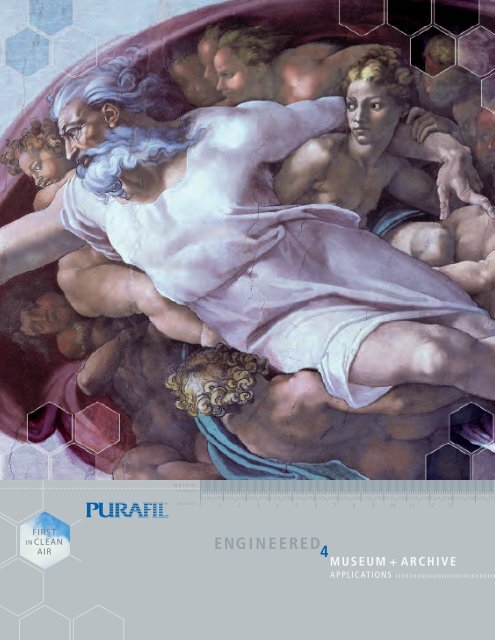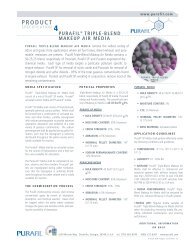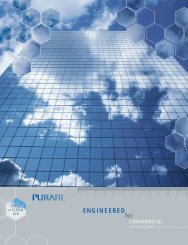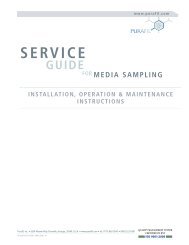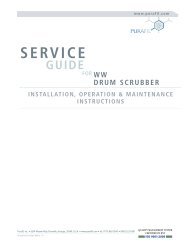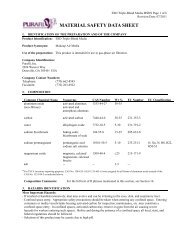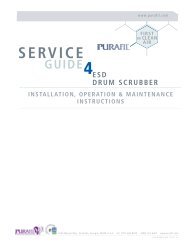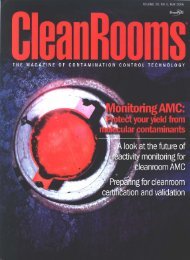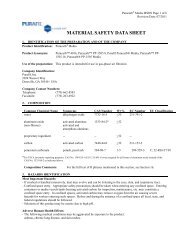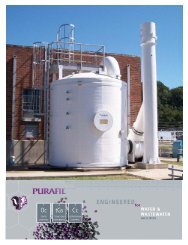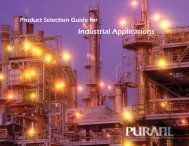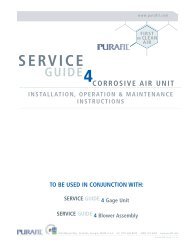IAQ in Museums and Archives - Air Quality Solutions and Controls
IAQ in Museums and Archives - Air Quality Solutions and Controls
IAQ in Museums and Archives - Air Quality Solutions and Controls
You also want an ePaper? Increase the reach of your titles
YUMPU automatically turns print PDFs into web optimized ePapers that Google loves.
METRIC<br />
MILLIMETERS<br />
CENTIMETERS<br />
1234 6789 1234 6789 1234 6789 1234 6789 1234 6789 1234 6789 1234 6789 1234 6789 1234 6789 1234 6789 1234 6789 1234 6789 1234 678<br />
5 5 5 5 5 5 5 5 5 5 5 5 5<br />
0 1 2 3 4 5 6 7 8 9 10 11 12 13<br />
FIRST<br />
IN CLEAN<br />
AIR<br />
ENGINEERED 4<br />
MUSEUM + ARCHIVE<br />
APPLICATIONS IIIIIIIIIIIIIIIIIIIIIIIIIIIIIIIIIIIII
1<br />
Iaq<br />
IMPROVING<br />
INDOOR AIR<br />
2<br />
Po<br />
PREVENTING<br />
ODORS<br />
3<br />
Se<br />
SAVING<br />
ENERGY<br />
////////////////<br />
IMPROVING INDOOR AIR QUALITY + PRESERVING ARTIFACTS /////////<br />
For more than 30 years, Purafil has provided clean air solutions to museums <strong>and</strong><br />
archives worldwide. Purafil specializes <strong>in</strong> the manufacture of air purification systems that<br />
remove gaseous <strong>and</strong> particulate contam<strong>in</strong>ants to safeguard <strong>and</strong> preserve artifacts.<br />
Sources of airborne pollution are everywhere — from automobile emissions to new office<br />
furnish<strong>in</strong>gs. Commonparticulate filters trap dust, pollen, <strong>and</strong> other particles, but only<br />
Purafil gas-phase air filtration systems elim<strong>in</strong>ate gaseous pollutants, the true sources of<br />
poor <strong>in</strong>door air quality <strong>and</strong> the deterioration of artifacts.<br />
IDENTIFYING THE PROBLEM:<br />
AIRBORNE POLLUTION<br />
Controll<strong>in</strong>g airborne pollutants is essential to ma<strong>in</strong>ta<strong>in</strong><strong>in</strong>g adequate <strong>in</strong>door air quality (<strong>IAQ</strong>) for museums <strong>and</strong> archives. Pollutants can<br />
come from outside <strong>and</strong> <strong>in</strong>side the build<strong>in</strong>g. Outside sources of odors, <strong>in</strong>clud<strong>in</strong>g the <strong>in</strong>c<strong>in</strong>erators, load<strong>in</strong>g docks <strong>and</strong> waste disposal units,<br />
are usually located at the rear of the build<strong>in</strong>g with<strong>in</strong> a few feet of primary HVAC air <strong>in</strong>takes. Emissions from nearby <strong>in</strong>dustrial facilities<br />
or residential furnaces can also result <strong>in</strong> damage to priceless pieces of artwork or archival material. Inside sources of pollution can<br />
<strong>in</strong>clude food service areas, clean<strong>in</strong>g aerosols <strong>and</strong> bioeffluents from guests. Office furnish<strong>in</strong>gs <strong>and</strong> pr<strong>in</strong>ters can worsen <strong>in</strong>door air quality.<br />
For clean <strong>in</strong>door air, Purafil offers an extensive product selection, from pleated chemical filters to modular front <strong>and</strong> side access units.<br />
Our systems are designed for easy ma<strong>in</strong>tenance <strong>and</strong> are <strong>in</strong>corporated <strong>in</strong>to your makeup, supply, or return airstreams.<br />
PURAFIL APPLICATIONS<br />
WITHIN MUSEUMS & ARCHIVES<br />
PRIMARY CAUSES AND EFFECTS<br />
OF GASEOUS CONTAMINATION IN<br />
MUSEUMS & ARCHIVES<br />
There are numerous locations with<strong>in</strong> museums <strong>and</strong> archives<br />
where gas-phase air filtration can be applied. Purafil offers<br />
a wide range of dry-chemical adsorbents called media, which<br />
are eng<strong>in</strong>eered to mitigate pollutants.<br />
APPLICATION AREA<br />
Cafeterias<br />
Offices<br />
GASEOUS POLLUTANTS<br />
Hydrogen sulfide, aldehydes,<br />
mercaptans, VOCs<br />
Sulfur dioxide, Nitrogen dioxide,<br />
Ozone, Acetic Acid<br />
CAUSE<br />
Burn<strong>in</strong>g of fuels <strong>in</strong><br />
power stations, factories,<br />
build<strong>in</strong>gs <strong>and</strong> automobiles<br />
Pr<strong>in</strong>ters <strong>and</strong> photocopiers<br />
Food service areas, solid<br />
waste disposal, clean<strong>in</strong>g<br />
compounds, cool<strong>in</strong>g towers<br />
GASEOUS POLLUTANTS<br />
• Sulfur dioxide<br />
• Nitrogen dioxide<br />
• Ozone<br />
• Ozone<br />
• Chlorides<br />
MATERIALS AFFECTED<br />
• Calcium carbonate<br />
(marble, limestone,<br />
frescoes, alkal<strong>in</strong>e, s<strong>and</strong>stones)<br />
• Cellulose (paper, cotton,<br />
l<strong>in</strong>en, wood veneers)<br />
• Silk<br />
• Iron<br />
• Steel<br />
• Organically-based materials<br />
(paper, textiles, animal<br />
sk<strong>in</strong>s, plant materials,<br />
pa<strong>in</strong>ts)<br />
• Metals<br />
• Metals<br />
Restoration/Conservation<br />
Laboratories<br />
Hydrogen chloride, formic acid,<br />
formaldehyde
WHICH AIR FILTRATION SYSTEM IS BEST?<br />
Purafil’s systems are built-to-order to meet the needs of your budget, space, <strong>and</strong> air h<strong>and</strong>l<strong>in</strong>g<br />
system. We offer solutions for retrofit applications <strong>and</strong> new construction.<br />
PURAFIL MEDIA<br />
Purafil offers a broad selection of dry-chemical adsorbents called media, which are the core of<br />
our built-to-order air purification systems. Purafil manufactures a wide variety of media to remove<br />
specific pollutants from specific sources. Purafil media remove contam<strong>in</strong>ants through a process known<br />
as chemisorption. Dur<strong>in</strong>g this <strong>in</strong>stantaneous process, gases are adsorbed, or captured on the surface of the<br />
media. Unlike adsorption, dur<strong>in</strong>g chemisoprtion the contam<strong>in</strong>ants are chemically transformed <strong>in</strong>to harmless solids that rema<strong>in</strong><br />
trapped <strong>in</strong>side the media. Once the gases are removed from your environment, they cannot re-enter the air stream.<br />
In most cases, we recommend Purafil ® SP Blend media because it removes the widest variety of odors <strong>and</strong> gases. SP Blend is a<br />
comb<strong>in</strong>ation of Purakol ® media, a premium grade activated carbon, <strong>and</strong> Purafil ® SP media, an activated alum<strong>in</strong>a substrate<br />
impregnated with the active <strong>in</strong>gredient sodium permanganate. While Purakol is highly effective at remov<strong>in</strong>g VOCs, it performs<br />
poorly aga<strong>in</strong>st hydrogen sulfide, sulfur dioxide <strong>and</strong> oxides of nitrogen. By us<strong>in</strong>g these media <strong>in</strong> comb<strong>in</strong>ation, Purafil can ensure<br />
the removal of all contam<strong>in</strong>ants.<br />
PURAFIL SIDE ACCESS SYSTEM (PSA)<br />
The PSA is designed for both particulate <strong>and</strong> gaseous<br />
contam<strong>in</strong>ant control <strong>and</strong> works <strong>in</strong> conjunction with the<br />
facility’s air h<strong>and</strong>l<strong>in</strong>g system. The PSA is a built-to-order<br />
system available <strong>in</strong> more than 20 size options. A full range<br />
of prefilter selections <strong>and</strong> particulate f<strong>in</strong>al filter selections<br />
are also available.<br />
POSITIVE PRESSURIZATION UNIT (PPU)<br />
The PPU is an all-<strong>in</strong>-one packaged air filtration mach<strong>in</strong>e for<br />
<strong>in</strong>door use. Both particulate <strong>and</strong> chemical filtration are <strong>in</strong>tegrated<br />
<strong>in</strong>to one unit, complete with a self-conta<strong>in</strong>ed blower.<br />
It is used to filter low to medium concentrations of<br />
gaseous pollutants while provid<strong>in</strong>g cont<strong>in</strong>uous positive<br />
pressure with<strong>in</strong> the space.<br />
RECIRCULATION AIR SYSTEM (RAS)<br />
The RAS, also designed to be located with<strong>in</strong> the protected<br />
space, is an air purification mach<strong>in</strong>e with recirculation as its<br />
primary function. The unit is used to further filter <strong>and</strong><br />
polish the room air to ma<strong>in</strong>ta<strong>in</strong> very low pollutant levels. It<br />
offers a number of advantages not present <strong>in</strong> filtration<br />
systems that are <strong>in</strong>tegral with the HVAC systems. Both<br />
particulate <strong>and</strong> chemical filtration <strong>and</strong> a self-conta<strong>in</strong>ed<br />
blower are comb<strong>in</strong>ed <strong>in</strong> one unit.<br />
PURAFILTER ®<br />
Purafil also recommends the use of the Purafilter, a comb<strong>in</strong>ation<br />
chemical <strong>and</strong> particulate filter designed to replace exist<strong>in</strong>g particulate<br />
filters <strong>in</strong> retrofit or rework applications. The Purafilter, which<br />
conta<strong>in</strong>s Purafil blended media, is useful <strong>in</strong> applications where space<br />
limitations exist.<br />
32X<br />
MAGNIFIED<br />
Purafil eng<strong>in</strong>eers are the first to successfully suspend sodium permanganate adsorbents<br />
<strong>in</strong> a bi-component fiber matrix, which does not require the use of adhesives,<br />
so adsorbents are fully exposed for reaction with gaseous chemical contam<strong>in</strong>ants<br />
<strong>and</strong> odors. Adsorbents are evenly distributed throughout the filter structure to assure<br />
the highest filtration efficiencies.<br />
16X<br />
MAGNIFIED
ENVIRONMENTAL ASSESSMENT<br />
Reactivity Monitor<strong>in</strong>g is a widely accepted technique used to characterize the destructive potential of an environment.<br />
Because many of the contam<strong>in</strong>ants targeted for control are corrosive <strong>in</strong> nature (i.e., sulfur dioxide), reactivity monitors have<br />
long been used to gauge the quality of ambient air <strong>and</strong> to <strong>in</strong>dicate the effectiveness of pollution control strategies.<br />
Purafil’s Environmental Reactivity Coupons (ERCs) may be used to <strong>in</strong>dicate the presence of sulfur dioxide,<br />
nitrogen dioxide, hydrogen sulfide <strong>and</strong> chlor<strong>in</strong>e compounds, which can cause deterioration of metals, cellulose or<br />
calcium carbonate with<strong>in</strong> museums, libraries <strong>and</strong> similar environments.<br />
For real-time corrosion monitor<strong>in</strong>g, Purafil offers the OnGuard ® Environmental Reactivity Monitor (ERM). The OnGuard ERM<br />
provides real-time <strong>in</strong>formation on the amount of corrosion occur<strong>in</strong>g due to the presence of corrosive gases.The ERM measurements<br />
are transmitted to the build<strong>in</strong>g management system via a 4-20 mA output signal. The ERM features copper <strong>and</strong> silver<br />
Quartz Crystal Microbalance (QCM) sensors for the detection of contam<strong>in</strong>ant concentrations as low as one part per billion.<br />
ENVIRONMENTAL CLASSIFCIATION<br />
Both Environmental Reactivity Coupons <strong>and</strong> the OnGuard ERM measure environmental reactivity <strong>in</strong> Angstroms, a unit of<br />
length equal to one ten-billionth of a meter. Purafil’s underst<strong>and</strong><strong>in</strong>g of the environmental challenges fac<strong>in</strong>g museums <strong>and</strong><br />
archives has led to the follow<strong>in</strong>g environmental classification scheme whereby monitor<strong>in</strong>g results correlate to vary<strong>in</strong>g<br />
degrees of air quality.<br />
COPPER CORROSION<br />
Class <strong>Air</strong> <strong>Quality</strong> Classification Reactivity Rate*<br />
C1 Extremely Pure


